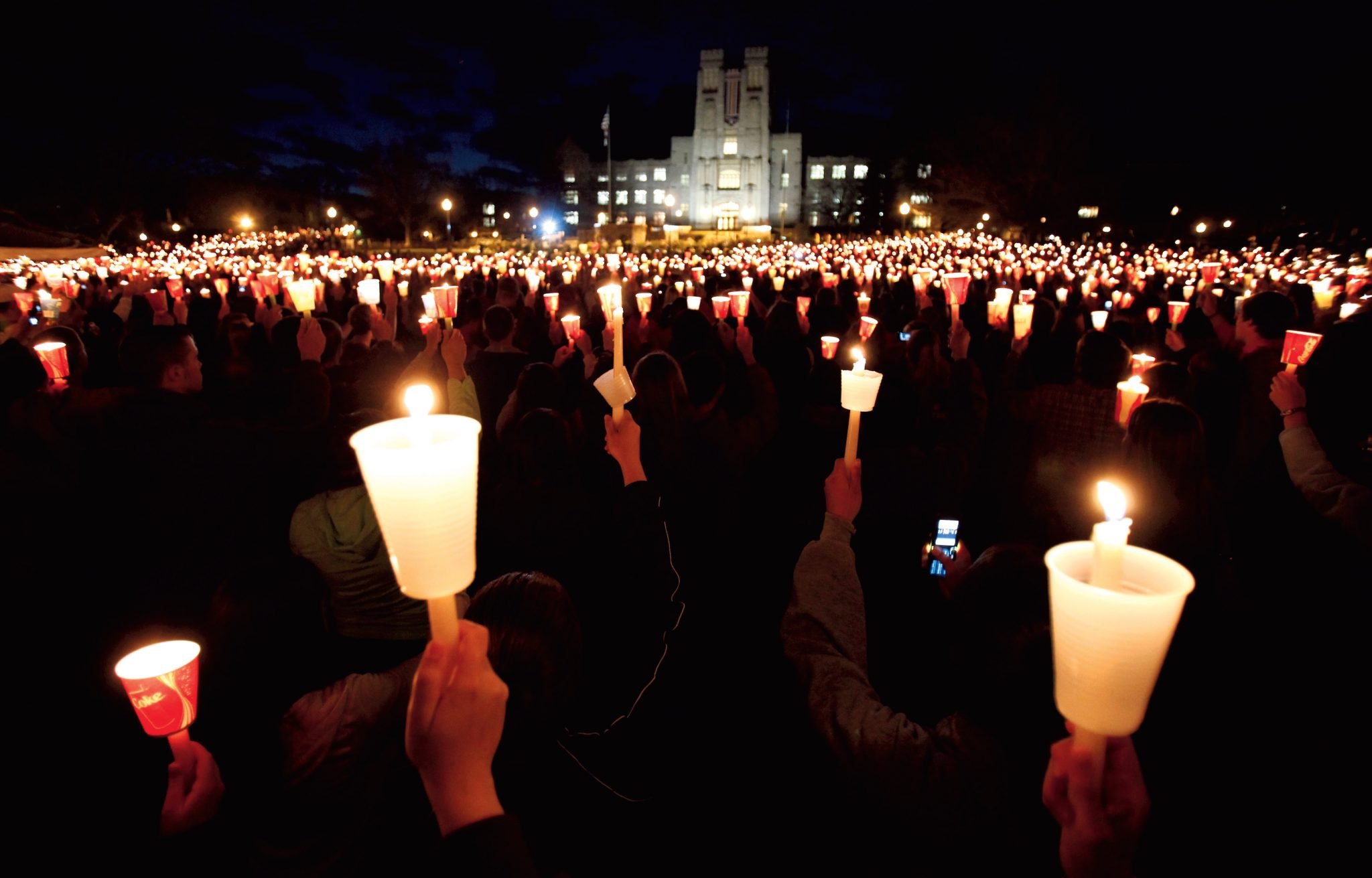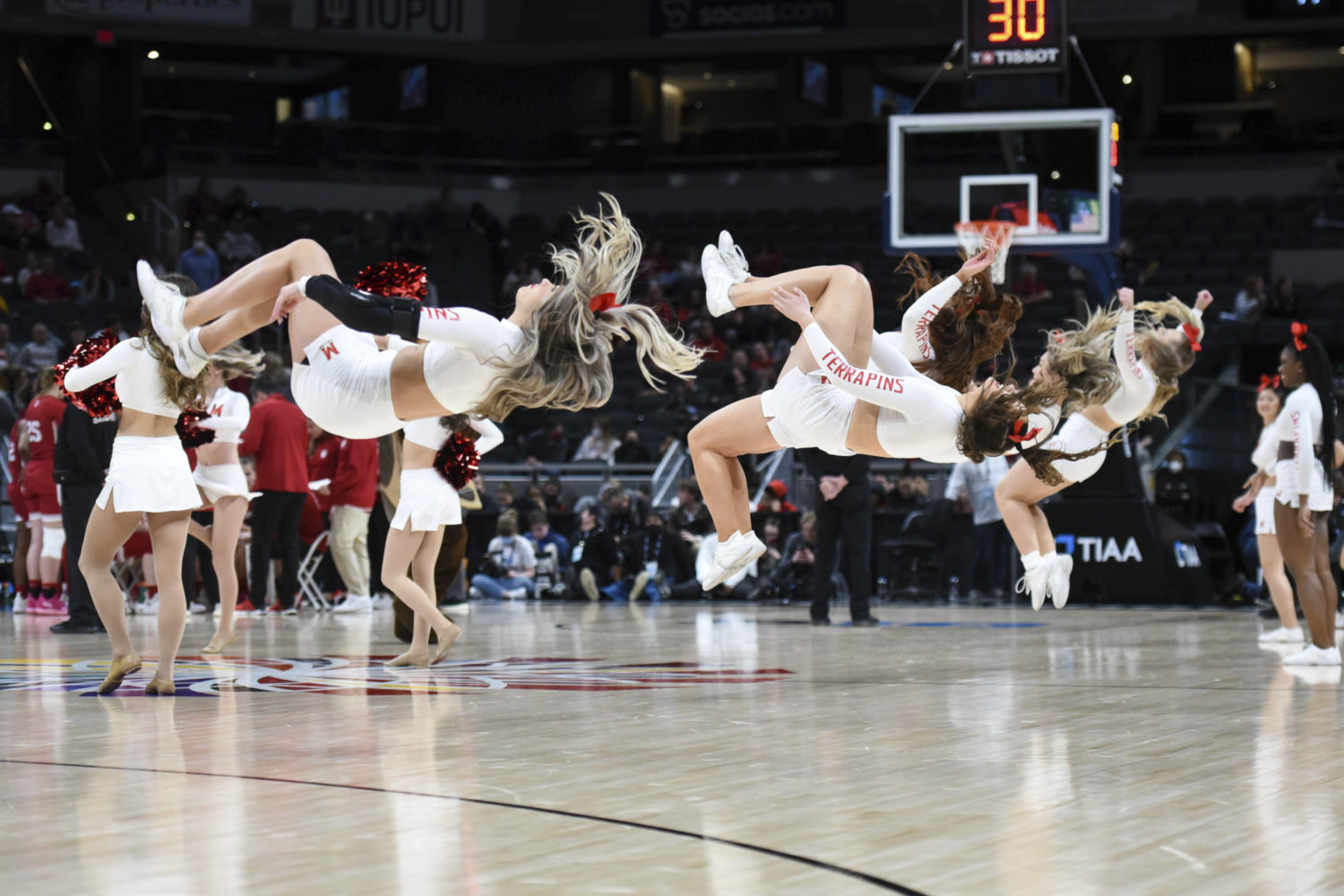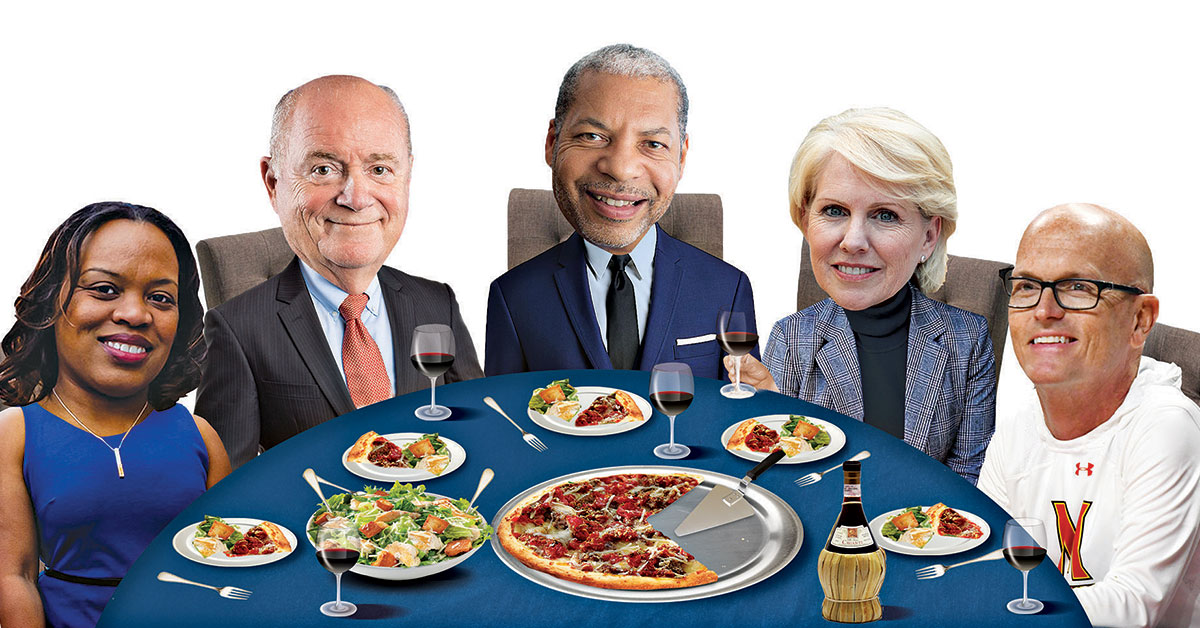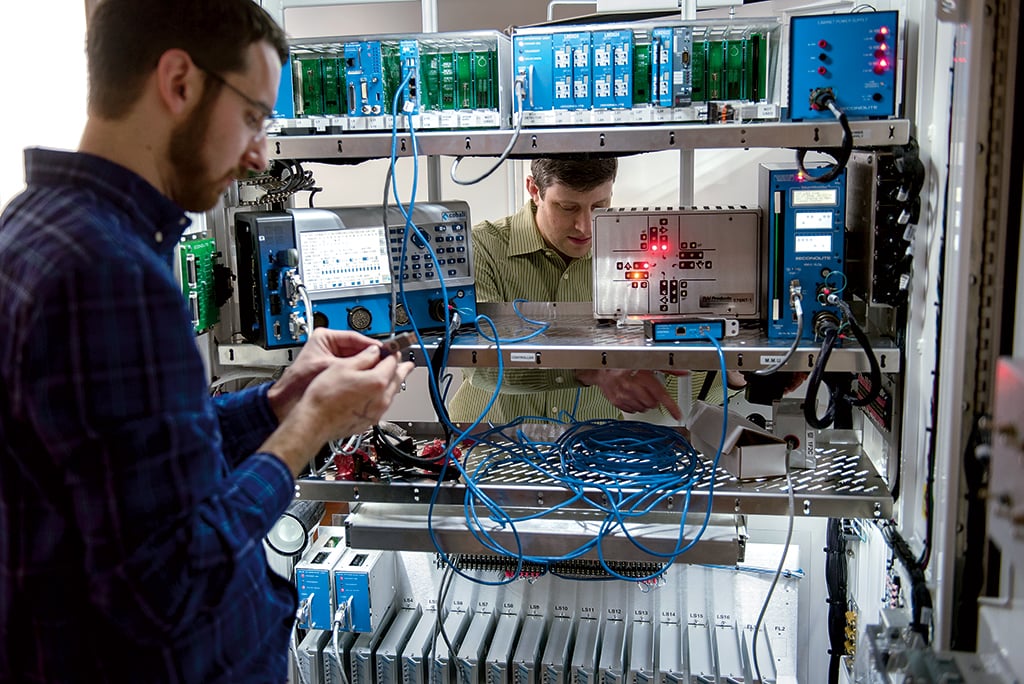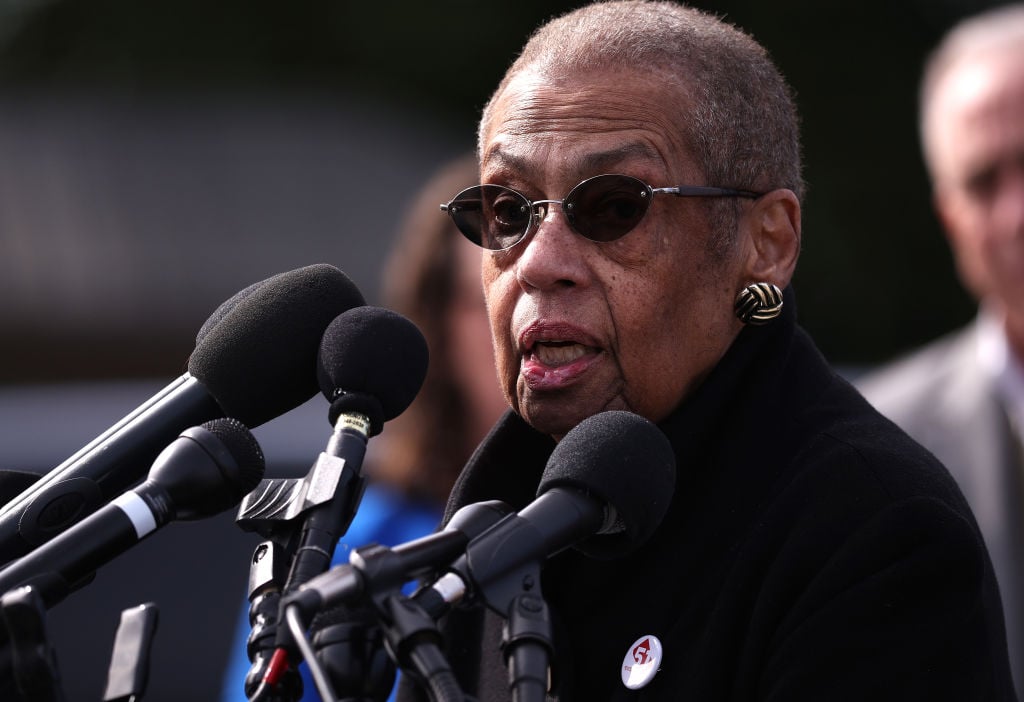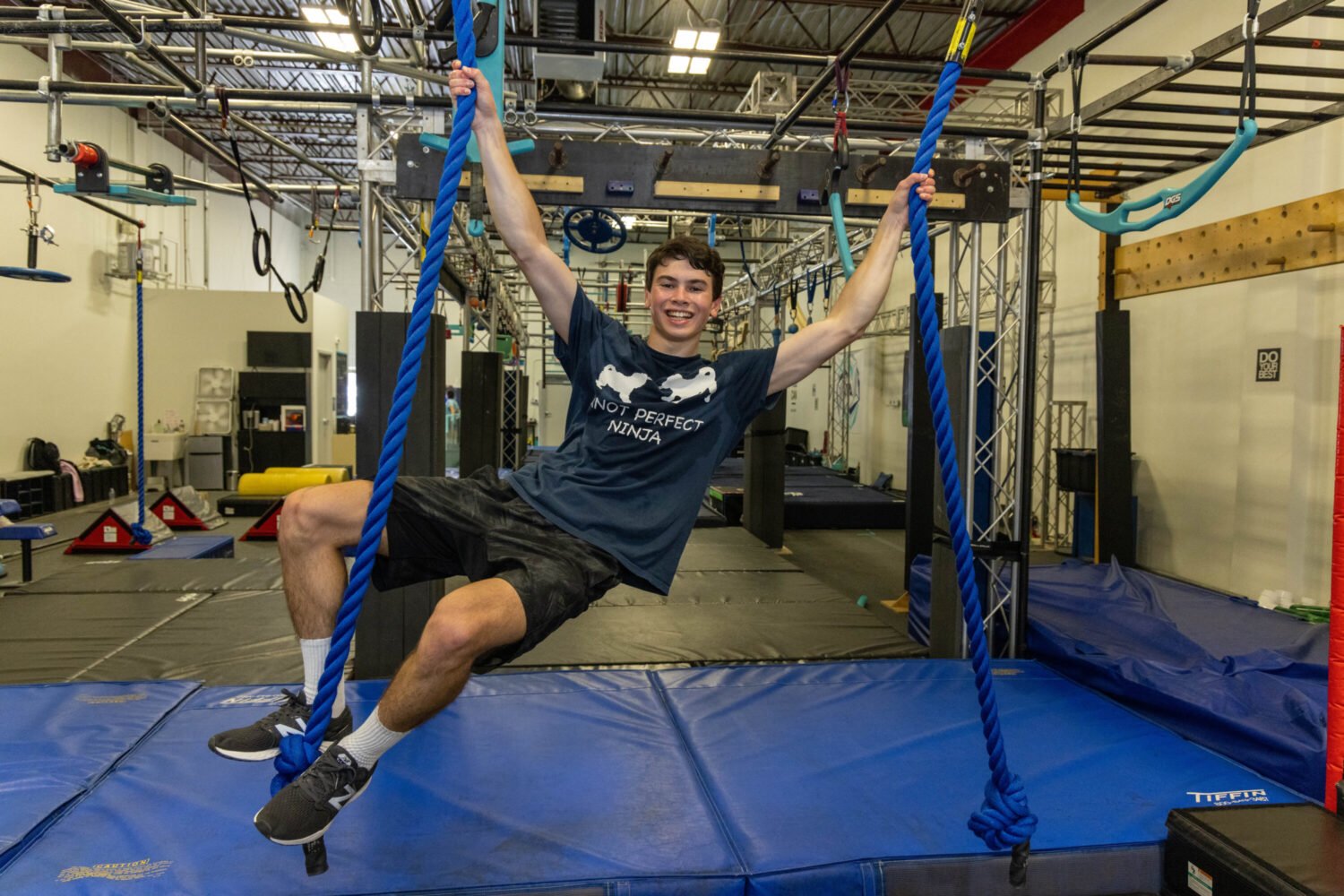Joe Samaha first heard on his car radio. Celeste Peterson’s friend called her at work. “There’s a shooting,” the friend said. Andrew Goddard saw it on the news and thought, Thank goodness my son wouldn’t be taking classes in an engineering building. Holly Adams turned on the television to see a body count. Renee Cloyd was nearby on Main Street and watched a stream of ambulances speed toward Virginia Tech’s campus, where her daughter was a freshman.
It was April 16, 2007—the morning when, shortly after the beginning of 9 a.m. classes, Seung Hui Cho wrapped chains around the door handles of Norris Hall and began a massacre that lasted 11 minutes, firing 174 rounds of semiautomatic ammunition. All told, Cho killed 33 people: beloved professors, talented graduate students, college freshmen determined to make a difference in the world, and at last, himself. At the time, it was the largest mass shooting in American history.
In the disorienting hours following the attack, victims’ families converged in Blacksburg, where they were housed at the Inn at Virginia Tech. The body-identification process took days. Because the media was camped in the faux-Gothic hotel’s parking lot, anxious relatives were essentially trapped inside. Slowly, some began to eat lunch together, to talk in their rooms, to vent at Tech officials.
It was, it turned out, the beginning of a community. That summer, they stayed in touch, wrestling with what to do. Sue the school? Ensure accountability some other way? Accept their terrible losses and move on?
At a June gathering in Chantilly, the families cried together and went back to debating what to do next. “Everybody wanted to be polite,” recalls Peterson, whose 18-year-old daughter, Erin, had been killed. She announced: “F— polite. My daughter is dead, and it’s all on them.”
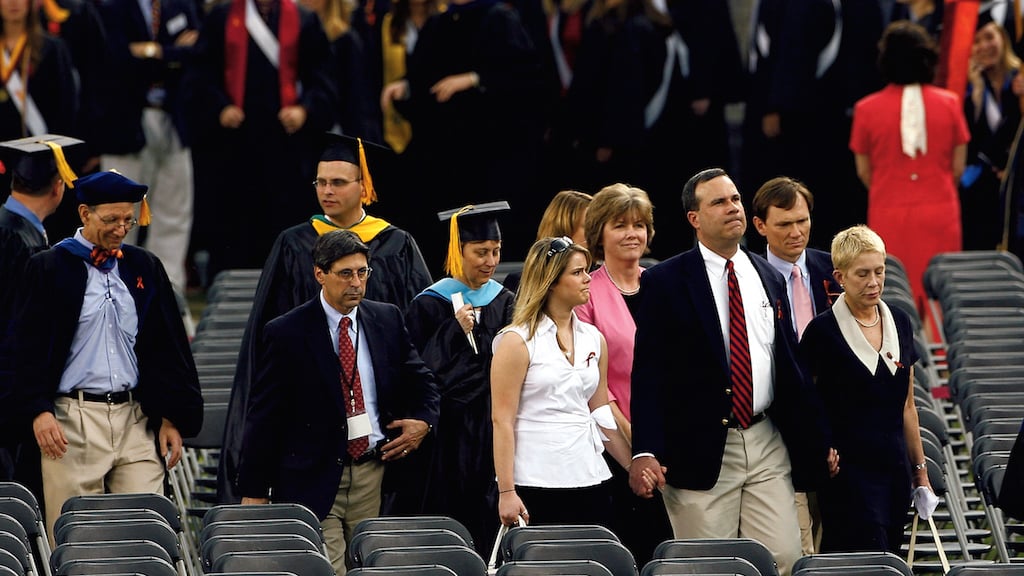
The 13 relatives who gathered that day ultimately emerged with a unified set of goals laid out in a public statement—that Virginia Tech be somehow held responsible for flaws in its mental-health procedures and the way it responded once the carnage began. There was another issue, one that seemed innocuous enough and was related to the goal of avoiding future tragedies. “We cannot let pass the point,” the group added, “that sensible gun control measures are in no way incompatible with anyone’s Constitutional rights and are at least as likely as some other recent suggestions to help prevent future tragedies of this nature.”
It felt like a way forward, a road map for working together toward a greater good. “As of today, we are no longer families,” C.B. Panchal, whose niece Minal had died in the attack, told the others before the meeting ended. “We are family.”
But within any family, priorities can evolve, allegiances can shift, politics can divide. The Virginia Tech “family” was no different. From the outset, it was being pulled in many directions, buffeted both by the familiar things that divide American society and by the more personal journeys of individual grief. Today, as its members still feel their way through unending loss, it’s a case study in how complicated it is to exist within a community knitted together by sorrow.
The Institutionalist
Where Joe Samaha comes from, a family is a village to be tended, guided, led. He is one of dozens of Samahas whose Lebanese ancestors imported that mentality into Northern Virginia a century ago, for years steered by his father, the “family patriarch.” After his death, Samaha assumed the role. Sundays, his immediate family—he, his wife, their three children—spent the day together, starting with church. For vacations, they traveled abroad to visit relatives.
Reema, the youngest of Samaha’s children, loved Family Guy and filming little sketch videos on 8-mm with her friends. She was the family’s entertainer. In ballet as a little girl, if she fell down, she’d act “as if it were one of her moves,” Samaha recalls. Virginia Tech wasn’t Reema’s first choice, but by spring of 2007, she was thriving in a dance troupe. That April, her parents visited to see her perform. Back home in Centreville, Samaha e-mailed Reema to say how proud he was watching her expand her circle of friends and connect with people of different cultures.
The next evening, the Samahas found themselves at the inn. Within an hour, they knew Reema was dead.
It wasn’t the school that broke the news. It was a stranger, a friend of a Lebanese EMT who knew Reema and knew that she had already been unofficially identified.
Samaha realized then that he had a new village to look after—the grieving. He began connecting families and helping facilitate meetings. “Was it a quasi–support group? Yeah,” Samaha says. He’s 61, a compact, neatly attired man with basset-hound eyes and a gold pendant with Reema’s image lasered onto it. “Could we talk to each other, say anything to each other, understand what we were going through? Absolutely. One hundred percent.”
But the gatherings also had a more practical purpose: assigning responsibility and creating change. “I’m a person that wants to get things done,” he says.
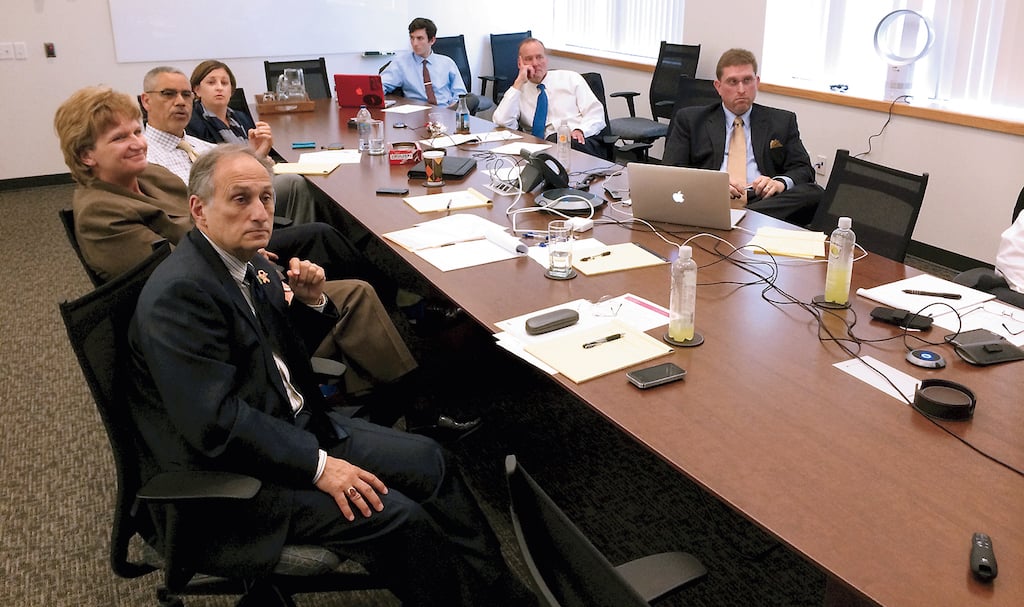
In August 2007, a state panel investigating Cho’s killing spree published its report, with more than 70 recommendations for how Virginia could prevent a repeat—including a universal background-check law. This catalyzed a raft of gun-control bills in the state legislature’s next session. Samaha got involved, traveling to the capitol to lobby and even sitting down with gun-rights groups.
His main focus, though, became steering his village toward some legal resolution with Tech. One of the first cracks came when he suggested funding a campus safety initiative as a condition of a settlement. Celeste Peterson and her husband recoiled from the idea: “Aw, hell no! I’m going to pay [VT] after they could have saved my daughter’s life but didn’t?”
In June 2008, most of the group decided not to sue. In exchange, the university offered a settlement: $11 million—$100,000 per family—along with other concessions. The settlement allocated additional money for a nonprofit called the VTV Family Outreach Foundation, which would do advocacy work on issues related to the tragedy. Samaha became its president.
As his gun-control efforts proved frustrating—and as the organization’s politics alienated a couple members of his Tech family as surely as they divided American society—Samaha began to tack the foundation in a less politicized direction, toward “campus safety,” an umbrella term for an array of issues including mental-health care, hazing, and bullying prevention.
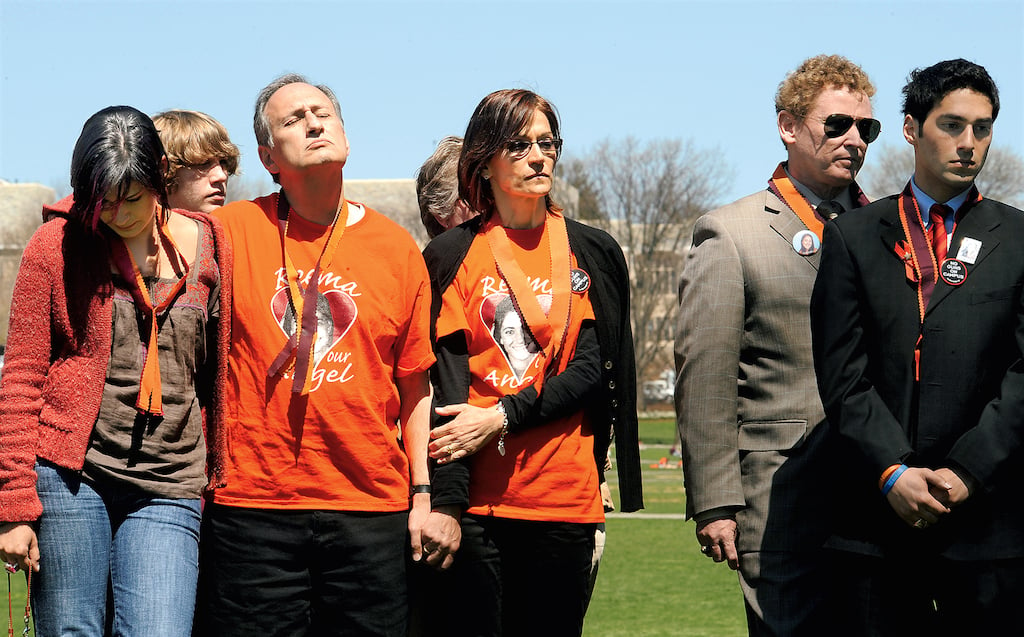
All these years later, some still feel constricted by the foundation’s hold over the “village,” including its control of the settlement money—in a sense, over the family legacy. “I don’t like it that they call it [the Family Outreach Foundation]. It implies that it’s all the Virginia Tech families that are involved, and it’s not,” one mother says.
Samaha points out that the money each family received in the settlement was separate from the foundation’s share. Mostly, though, he sounds hurt to hear that people continue to debate the foundation’s role. For him, “the best way to honor our loved ones is to keep it nonpolitical. These lives are above all that. They’re much greater than bickering and politics.”
Every year, the foundation holds an event for families and survivors. It’s part business and part reunion/wellness re-treat, with activities such as relaxation exercises. “Oh, it’s wonderful—those are the biggest hit,” Samaha says. “You know, the massages, the breathing, yoga.”
Lately, though, attendance has dropped off. Where there used to be 30 or 40, last year there were maybe 20, he says. The village is getting smaller: “You know, as time goes on, people are in a better place.” Even so, Samaha still feels connected to the others and is constantly seeking to bring new people in. This year, he reached out to students who were in Norris but not wounded, yet experiencing symptoms of posttraumatic stress long after the fact. “We didn’t ask to be family members—right?” he says. “[But] now I have this huge family that I tremendously love and feel for and understand. Even though some of us took different paths . . . .”
The Justice Seeker
After they learned Erin was a victim, Celeste Peterson and her husband, Grafton, talked about committing suicide. Instead, they pursued justice.
Peterson was horrified to learn through the panel report that many students could have been saved if school officials had issued a more timely warning after Cho killed two students elsewhere on campus 2½ hours before entering Norris Hall. She was baffled when the university president, Charles Steger, didn’t reach out personally—but did send football tickets. For the Petersons, joining Samaha and the other families who settled with the school was out of the question. Instead, the couple filed a wrongful-death suit. Not for money—they knew from the start that Virginia had a $100,000 liability cap. The Petersons wanted Tech to apologize, Celeste says. Fresh-faced in her fifties, she talks about the trial with weary precision, occasionally yielding to a kind of shocked laughter. “That’s all we wanted them to say: ‘You’re right, you’re right. We didn’t know what we were doing.’ ”
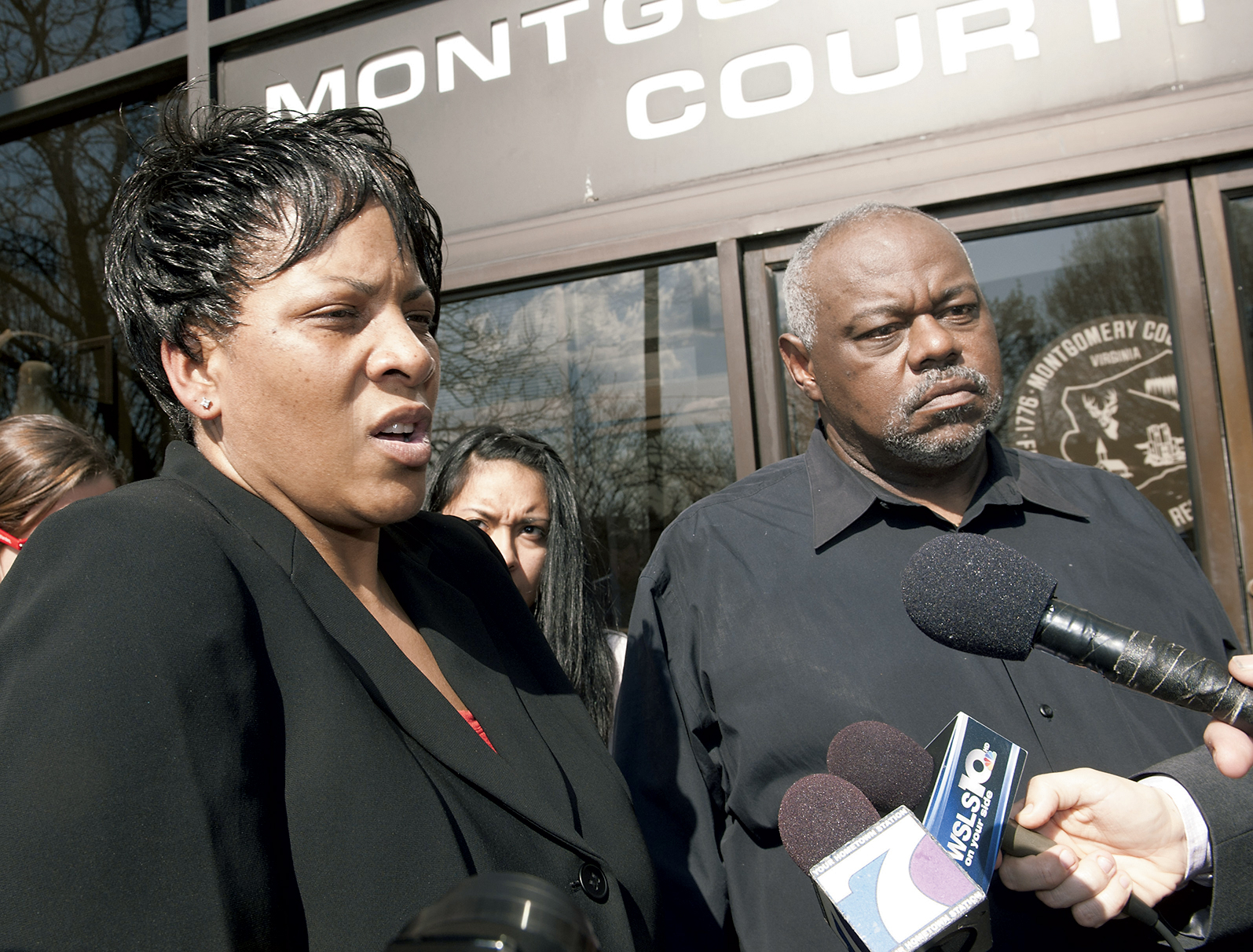
So began a six-year odyssey that preoccupied Grafton especially. Erin was the couple’s only child. Two days before her birth, Grafton’s eight-year-old daughter from an earlier relationship had died of cancer. He worked multiple jobs as a construction supervisor so Erin could have a comfortable middle-class life—but when he was at home in Centreville, Celeste says, he was “just holding Erin, just holding her.” When Erin got to Virginia Tech, she called home every night.
After losing two daughters, Grafton was not going to lose in court. He drove across the state to every pretrial hearing, read every filing. In March 2012, five years after the tragedy, Steger was called to the witness stand of a circuit court in Christiansburg, five miles from Tech. “Given what we knew at the time,” he testified, “we believe we did the best we could.” The jury disagreed. It found unanimously in favor of the Petersons.
Celeste and Grafton wept and embraced, thanked God, prayed.
The following year, however, the state Supreme Court dismissed the verdict. Grafton took the loss hard. “The trial kind of kept him alive,” Celeste says. “And then when that was over with, it was just, you know. . . . He just wanted them to hurt the way he did. But you can’t do that.”
In the years that followed, he suffered various health problems and at one point nearly had to have a foot amputated. Late one night in March of 2016, Celeste heard a strange noise in the hallway outside her room. She found Grafton lying there unresponsive, drenched in sweat. She thinks he was trying to get to her when the heart attack hit. Her partner in grief and in war, the husband she called “the water to my fire,” the person who knew how to calm her down when she started crying uncontrollably about a burnt-out light bulb, was gone.
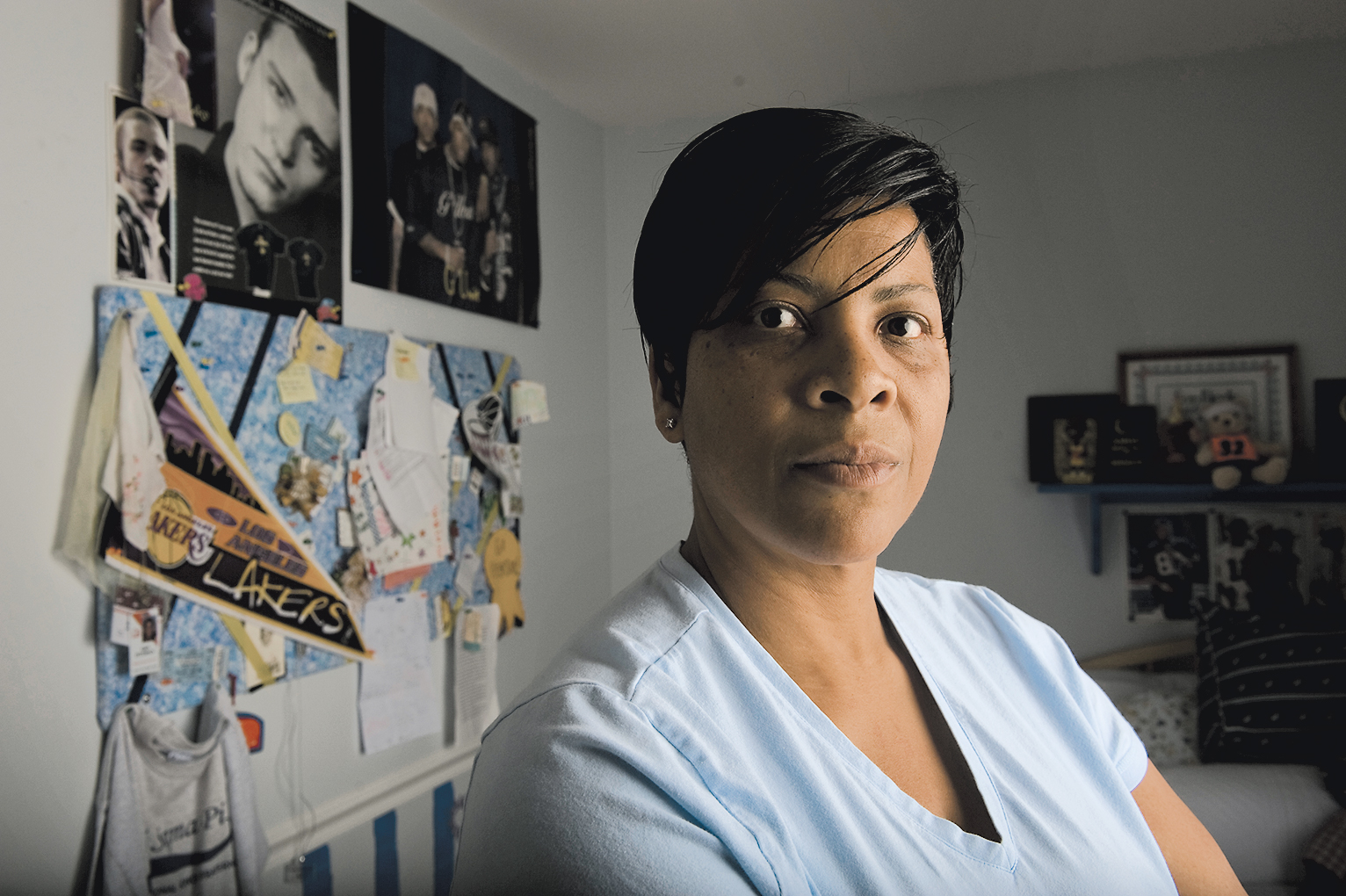
Today, Celeste says, Erin still shapes her life. When Erin, on her way off to college, said she wanted to work in nonprofits after graduation, Celeste was surprised: “All I could say was ‘Eh. How can I recoup my investment?’ ” But with Erin and Grafton both gone, Celeste has kept her life full the way Erin dreamed of doing.
Along with her job at a defense contractor, she runs the Erin Peterson Fund. It has given away $180,000 in scholarships and grants for teenagers and supports local high schools, including Erin’s alma mater in Fairfax County. Despite the drumbeat of new mass shootings since Virginia Tech, she nonetheless is hopeful about her ability to make a difference. “I feel like there’s change on the horizon,” she says. “I think I can help it on this end.”
The Activist
Andrew Goddard studied to be an engineer in his native England, then went to Kenya and helped build a settlement for people displaced by war and drought. It was the beginning of a 20-year career in overseas disaster relief and infrastructure work. Establishing a camp in Tanzania at the end of the Rwandan genocide, coordinating logistics with a US military task force in Bangladesh after a cyclone—his toughest assignments taught him he was most effective at “dropping into a dangerous and difficult place and making a plan of action and getting it done.”
After his son, Colin, was wounded by Cho, Goddard began parachuting into a danger zone much closer to home: the Richmond statehouse. Over the past ten years, he has become a nearly one-man strike force fighting the gun lobby with rapid-fire talking points, dry wit, and a single-minded focus. “I don’t know if I could do this if I had lost Colin,” he says. “Because then it would be much more difficult to dissociate the personal.”
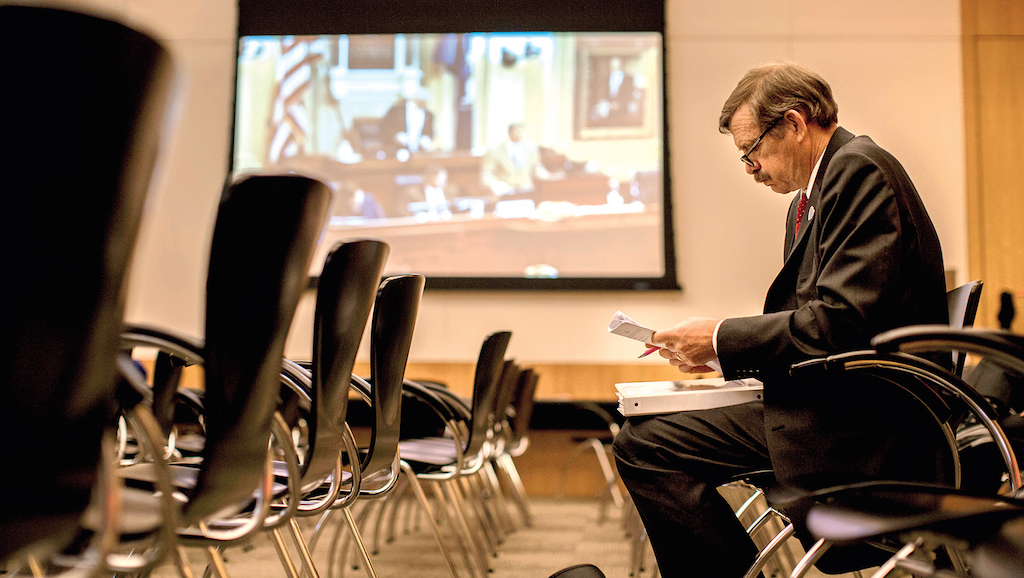
Colin was with Reema Samaha and Erin Peterson in French class that morning. Cho shot him four times in his legs, pelvis, and shoulder. After surgery, three bullets remained in his body and he couldn’t walk. So Goddard moved from Richmond to Blacksburg, sleeping on a blowup mattress in Colin’s apartment. “At the very beginning, we didn’t know what long-term prognosis there was for him,” Goddard says.
Before the attack, Goddard had noticed a lump on his neck. Over the weeks walking Colin to the bathroom, he forgot about it. Come summer, Goddard finally saw a doctor and learned he had secondary cancer of the lymph nodes on his throat. He began radiation and chemo, had surgery, and lost 50 pounds. What the hell else could go wrong this year? he sometimes thought.
Yet the agony of caring for his injured son while stomaching the chemicals pumped into his own body did little to stifle Goddard’s will to bulldoze his way into Richmond. “I was amazed to hear the gun lobby’s side,” he says. “When you hear them expounding on the virtues of a gun in every hand, it’s chilling, especially when you didn’t grow up with that.”
He was so weak that some days he couldn’t walk all four flights of stairs to the statehouse gallery. Half his neck had been removed in a “radical dissection” surgery. Still, he kept going.
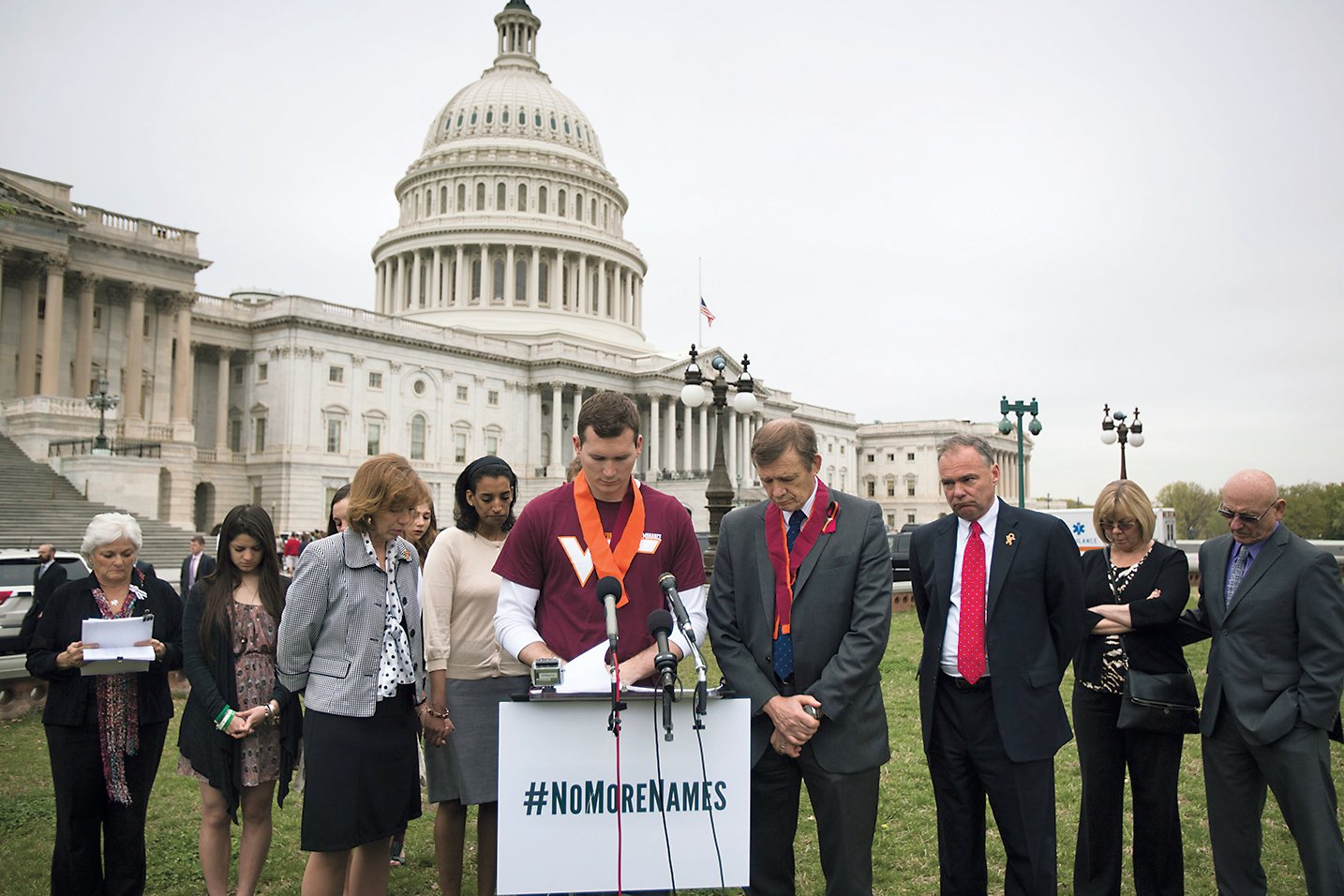
The defeats were numerous in the early years. The NRA’s headquarters are in Fairfax, only 100 miles from the statehouse, and that proximity has made Virginia friendly to the cause even as the state has turned bluer. But in a perversely motivating way, this means that Goddard has had nowhere to go but up—or at least sideways. “In the early days . . . they would come with a shopping list of bills . . . and they would get some of them,” he says. “Over time, we managed to fight them to a draw.”
It’s a painstaking pursuit. Before every session, Goddard sits down with the 3,000 or so filed bills and pulls out the 90 related to gun violence. He reads them word by word. Then he starts working on his defense, researching arguments for testimony before often unfriendly panels, contacting experts when necessary. Drawing on skills from his engineering days, he keeps intricately color-coded spreadsheets—all the bills, all the votes, how lawmakers score.
He has found an ally in Lori Haas, the mother of a survivor named Emily. Emily completed Colin Goddard’s call to 911 after he was shot, shielding his phone with her hair so Cho wouldn’t hear anything as he paced through their classroom. Lori Haas is now Virginia state director for the Coalition to Stop Gun Violence, focusing on the people end of things. “I find it easier to deal with legislation,” Andrew Goddard says.
Sometimes, he and Haas testify about more than 25 bills a day.
Goddard says he tries to draw on facts, but also to make his listeners “uncomfortable. . . . What would you say if this were your daughter? I’m trying to get them to imagine themselves in a bad situation.” If a bill ends up at the governor’s desk, so does Goddard, following it all the way up the chain to lobby for a veto—which, under Democratic governors, he has gotten. Today his son is married with a child, long independent and healthy. Goddard—whose cancer is in remission—says he doesn’t even think about Colin anymore when preparing his testimony. The thing that keeps him going is meeting with other people who have had loved ones gunned down. “There’s always new families,” he says. “It goes on at such a ridiculous rate that something just has to be done.”
The Gun Owner
Holly Adams tried rallying around gun control right after her daughter Leslie Sherman died in Norris Hall. She hadn’t much grappled with gun politics before and thought, Yeah, this sounds good—gun control. But whereas Goddard was energized by activism, Adams was turned off when she met Democratic lawmakers and advocates with other families. “Uh-uh, that’s not me,” she said to herself.
Adams had grown up on a farm in rural Washington state, clearing land with a pitchfork and entering 4-H competitions at a young age. She’d roam the nearby hills alone, collecting insects and sticking them into the freezer for her mother to find. In her twenties, she joined the Navy. She did tours in Guantánamo Bay, Alaska, DC, Georgia, and Germany and, after retiring as a lieutenant commander, worked across the globe for the Navy as a civilian. The family loved private jokes and nicknames. Adams and her husband called Leslie “Roo” for the rooster-like tuft of hair on her head.
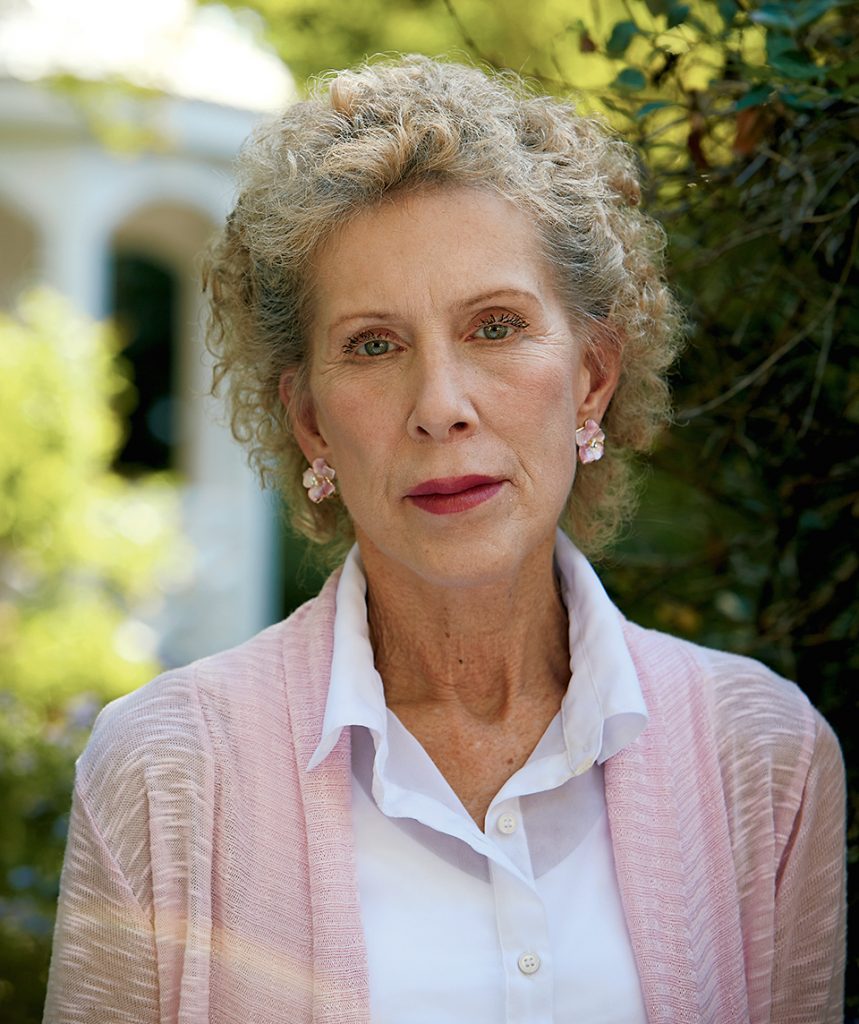
Leslie inherited her mother’s love of travel. Twenty when she was killed, she was a history and international-studies double major. She saved every penny she earned as a Wegmans cashier for trips to Ecuador and Argentina and was studying French and Russian to join the Peace Corps and, later, the Foreign Service.
In the days after the funeral, Adams—then an investigator for the Office of Naval Research in Arlington—joined forces with the other families to dig into Tech’s mistakes. She considered suing as the Petersons did, but she and her husband decided not to. It turned out that keeping tabs on the state panel’s investigation, weighing how to proceed and whether to settle, supplied a coping mechanism against her overwhelming sadness. Once she opted to join the settlement, Adams says, “that was when the real pain set in.” It became too hard to be around the others, and she retreated from the group. “The one thing that we all had in common,” she says, “is the one thing we want to forget.”
On her own, Holly coped by going to therapy and painting in a studio in Alexandria, where she began teaching night classes, partly as a means of distraction: “I can pretend I’m anywhere when I’m plugging away at a picture.”
Politically, she moved in a very different direction. As a kid, Adams had hunted magpies with a pellet gun; in the Navy, she’d trained on pistols and rifles. But before the tragedy, she hadn’t thought of herself as a gun-rights supporter. Over the years that followed, however, she began talking to some close family friends about Second Amendment issues. They encouraged her to practice at the range with them and buy her first gun, a Beretta pistol. One was involved in the Virginia Citizens Defense League (VCDL), a gun-rights organization, and invited her to come along to a meeting, “because he thought I would be a good spokesperson for the cause.” Her friends told her story for her, and everyone applauded.
The one thing that we all had in common is the one thing we want to forget.
Adams thought at first that perhaps she’d found the fellowship that had eluded her among the VT families. She says she was in the “anger” stage of grieving, and it infuriated her to think about “idiots who wanted to control guns and take them away from honest citizens when you’ve got no control over criminals who are going to get them anyway.” When someone from the NRA magazine, America’s 1st Freedom, interviewed her for a 2013 story, she revealed: “I would give anything if that day, that morning, somebody in the classroom was armed and could have stood up and taken Cho out before he got 32 victims.”
But after she attended several more VCDL meetings, that crowd didn’t feel like hers, either. “Basically, the same old guy gets up and talks for an hour and a half pontificating about the same old things,” she says, “and then the meeting’s over and they all want to go out and get beer and pretzels down the street.”
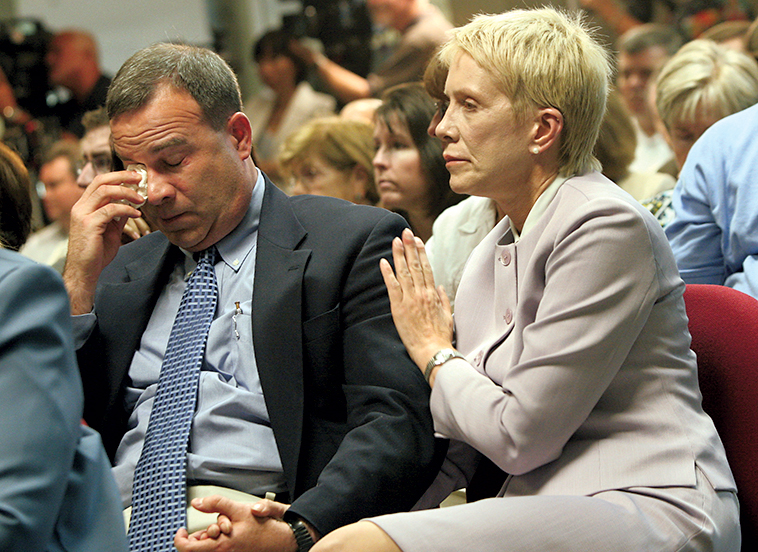
These days, Adams is focused mostly on her family—spending time with her husband at the Gulf Coast condo they recently bought in Mississippi, decorating for Christmas last year for the first time since Leslie died.
Adams is still healing, with help from a perhaps unexpected source: Lynnette Alameddine, a gun-control advocate whose son was also killed at Tech. The women have been friends ever since—regardless of politics. This past winter, around the time of the Ohio State rampage, Adams says they spoke nearly every day, sharing their grief in a way not many other people can handle ten years after the fact: “She’ll let me talk about Leslie, whereas nobody else wants to think about it.”
Adams’s position today is more nuanced. She still cares about gun rights but supports stronger background checks and says she can imagine some room for compromise about concealed-carry on campuses. She still likes to shoot. During a recent trip to the range, she wrote bad guys on one target. On another, she wrote CHO. There was no competition between them, she says. “I did so much better with Cho.”
The Local
As Renee Cloyd arrived at her Blacksburg church to volunteer early on April 16, her husband, Bryan, then a Tech accounting professor, was under lockdown inside Tech’s business school—a stone’s throw from where their 18-year-old daughter, Austin, had been shot. Of all the victims’ parents, the Cloyds were the only ones who lived in town. They also weren’t interested in attending the family meetings that summer of 2007. “My husband and I said, ‘I can’t do that. I can’t handle their anger and pain also,’ ” Renee remembers.
The Cloyds had moved to Blacksburg in 2005. Renee, an outgoing woman with a Carolina drawl, had been a stay-at-home mother most of her adult life. Now her kids were both in their teens, and she was starting to think about how she’d spend her time once they went off to college. Austin was her “identity.” The two talked about sex, God, and the finer points of Gilmore Girls, about Austin’s plans to move to Australia after college and have six children, five adopted. In the summer, they did volunteer work together, nailing shingles onto the roofs of rundown homes in central Appalachia.
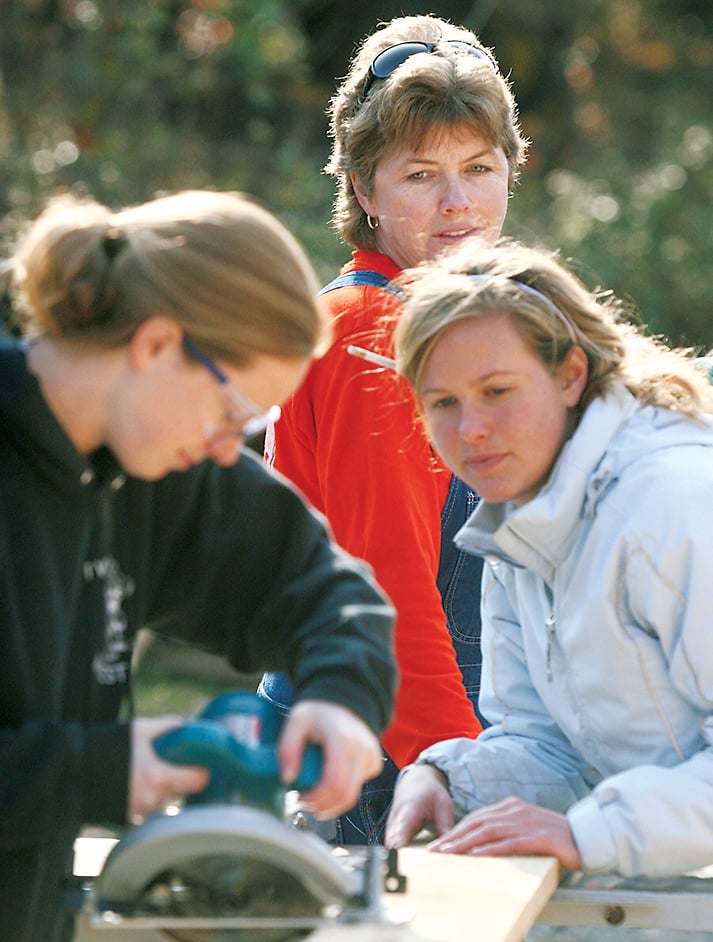
Those first few years, Renee’s connection to the college town had felt transitional. But after the massacre, unlike other relatives who found it painful to visit—who even experienced physical symptoms while there—Renee drew comfort from the community grieving alongside her. Not long after the shooting, she saw a little girl in the supermarket being picked up by her father and it made her think of Austin. She broke down, and a stranger who recognized her gave her a hug. Members of her church reading group brought food, took out the trash, helped spray Austin’s favorite Clinique “Happy” scent onto the pink funeral programs.
After the shooting, the Cloyds used memorial donations to bring 150 Tech students with them on volunteer trips organized by the Appalachia program Renee and Austin had worked for. The experience helped the Cloyds gain perspective. “We were with a woman whose husband had just died four months prior and could feel the wind coming through her house—she had nothing,” Renee says. “We still had a nice home. We still had retirement accounts.”
The Cloyds continued to keep their distance from the other families. There were geographic and political differences. Renee isn’t a gun-rights proponent and thinks the NRA is “too powerful,” but she couldn’t get onboard with the gun-control activism: “In southwest Virginia, if you’re living out in the middle of the woods, you need to have a gun.”
While the others debated sue versus settle, Renee and Bryan thought about just walking away. (They eventually joined the settlement.) While other families blamed Tech for a number of mistakes along the way to April 16, Renee forgave school officials. “I think they did the best they could,” she says. “If they had known different, would they have done different? Yes. I cannot imagine the weight that they bear.” She says it was her faith that helped her get there, along with her family history; growing up with an abusive father, she’d taught herself to forgive in order to survive.
As they mourned, the Cloyds built a house on a mountaintop, with high ceilings and views of Tech’s campus below. Upstairs, a single bed sits made and ready in “Austin’s room.” Her ashes rest in a box on the mantle in the family room.
Once a couple of years passed, Renee returned to some of the questions she’d been pondering before Austin went to college, and she wondered what she was going to do by herself in an empty house. She signed up for a certificate program from Tech and then, in 2011, got a job helping run a business-school summer program for minority and first-generation students.
It was there that Renee grew friendlier with a person many Tech parents saw as the enemy—university president Charles Steger.
She had known him a little over the years, but now when she saw him on campus, she’d give him a hug. Although she believes, as many family members do, that Steger had been instructed by Tech lawyers not to apologize, “if you actually looked the man in the eye and watched him and talked to him, you knew that he was sorry with his whole being.”
In 2013, just before Steger announced his retirement, Renee went to Tech’s moment of silence on April 16 and then stopped by his office. He invited her to sit down, and she noticed he had tears in his eyes. “I look at the man and I said, ‘How are you doing?’ ” she recalls. Steger didn’t really reply. He just looked back at her and said, “I didn’t lose anybody that day. How are you doing?”
When Tech holds its annual “Day of remembrance” on April 16 this year, not all the family members will be there. Joe Samaha has gone to nearly every one and plans to attend again. Andrew Goddard missed the last few but is going this year. Holly Adams let her family decide; they voted no. Celeste Peterson won’t be there, either—she has mostly avoided Blacksburg since she and Grafton went to find Erin ten years ago.
As she explains it, April 16 is no more momentous than any other day of the year. The sorrow of losing a child may change over time, but it’s always present. “It’s like walking around with a rock in your pocket,” Peterson says. “Initially, you bump up against things. . . . It’s uncomfortable. After a while, some days you don’t know it’s there. Some days you bump up against things and you realize it’s there. Some days it just feels really heavy. It’s never going to go away.”
For Renee Cloyd, who also won’t attend—it’s Easter Sunday—it’s more important to connect with her church, and her own family, rather than the others. “Yes, we might have all lost a loved one in similar circumstances, but the only thing that ties us together is that moment and that moment only, and then we go on our own paths of healing, sometimes together and sometimes separate,” she says. “You have to give space and grace to one another.”
Contributing editor Britt Peterson (brittpeterson2@gmail.com) also writes for Elle and the Atlantic.
This article appears in the April 2017 issue of Washingtonian.

